
One Big Scam
Any discussion of ANY filter requires a disclaimer. ALL commercial filters almost without exception tell the owner to replace the filter media (cartridges, sponge, ceramic rings, carbon, Matrix, etc.) regularly, once a month, once every three months, or once every six months. Supposedly this is because the media becomes clogged and dirty. And the media is ridiculously expensive. We must emphasize:
.
Replacing the Filter Media is a Big SCAM!!!
.
Yes, there is absolutely no reason to replace the media regularly other than to make a lot of money for the supplier of the filter. And when filter media is replaced (or cleaned well) one loses most of the beneficial bacteria and starts the cycle all over again.
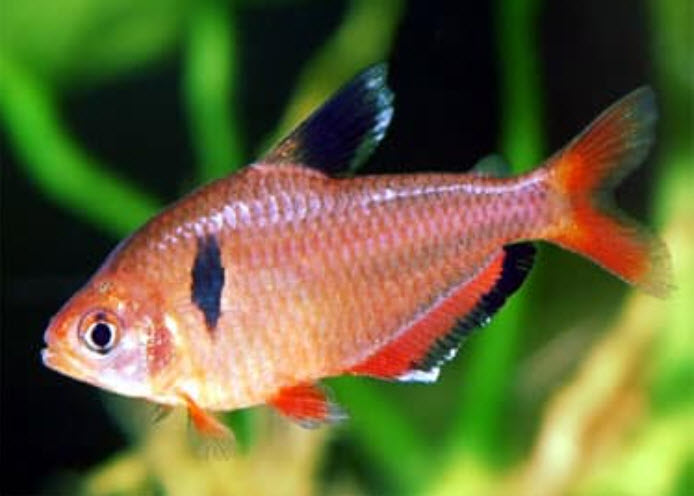
Aquarium Filters
Every aquarium needs a filter to do the biofiltration. Most beginners to the hobby get a small hang on the back or internal cartridge filter and follow the instructions to change the filter cartridge once a month. This is a huge mistake. The instructions are a profit-motivated scam. It simply doesn’t work. There ends up being no biofiltration (biofiltration is the removal of poisonous fish pee by slow-growing beneficial bacteria colonies on the filter media) at all in the aquarium.
If one has a cartridge filter, do not replace the cartridges every month. Instead, clean the outside (and ONLY the outside) of the cartridge with a brush every few weeks to every few months. Avoid cleaning or changing the media inside the cartridge (typically this is activated carbon). The “brown gunk” that builds upon this media is a very good beneficial bacteria that help keep the fish healthy. It is not fish poop! “Beneficial bacteria ain’t pretty”.
Any newcomer to the fish hobby should get an under-gravel filter. One must now purchase them over the internet as most fish shops have stopped selling them. Under-gravel filters don’t have enough of a profit margin. Under-gravel filters give great biofiltration if they are not cleaned for years at a time. If under-gravel filters are cleaned on a regular basis they do not work well and they are a high maintenance pain in the butt.
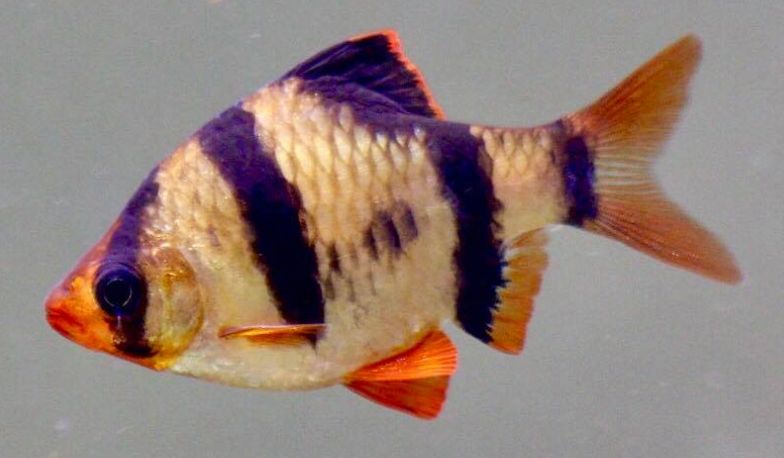
Filter Options
These filters have many different aspects which need to be considered.
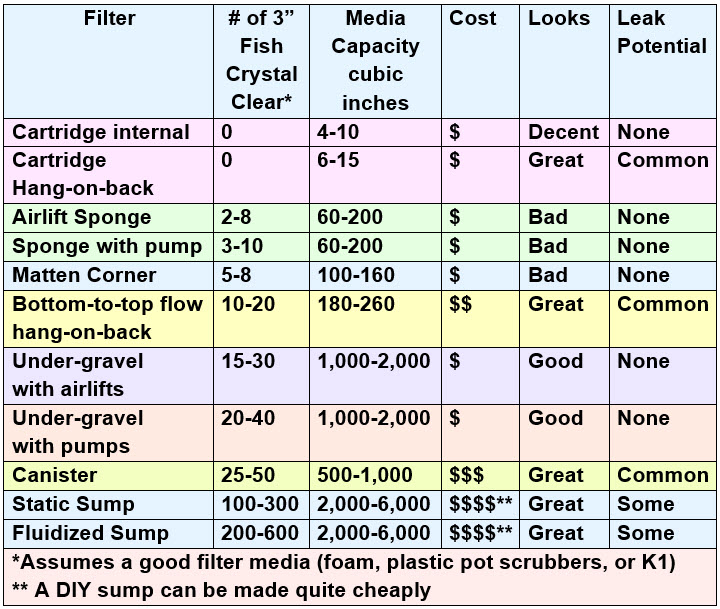
*# of 3″ Fish refers to the number of three-inch fish that can be given crystal clear water with this filter. Note this chart is a very very gross approximation. Also, this review assumes a typical 29 to 40-gallon tank with correspondingly sized filters. And it assumes that an overflow siphon is not visually objectionable while a dirty sponge sitting in a tank is objectionable.
Note these are only the most common filtration methods. There are a great many other methods used for filtration. These methods are reviewed in depth in the following article:
8. Filters

Ammonia oxidation is a much easier process than giving clear water. The ammonia load of these filters can be twenty times the number of three-inch fish listed.
The larger the fish and the more fish the more cubic inches of media are needed. All these filters have their pluses and their minuses. Which one you use is a matter of personal preference and wallet size.
All these types of filters can be used successfully. Combinations of hang-on-backs (HOBs) and under-gravel are great (HOB does mechanical, under-gravel does biological). And sponge filters are great for breeding tanks but kind of ugly in decorative tanks. Large tanks with lots of fish and/or large fish do best with sumps.
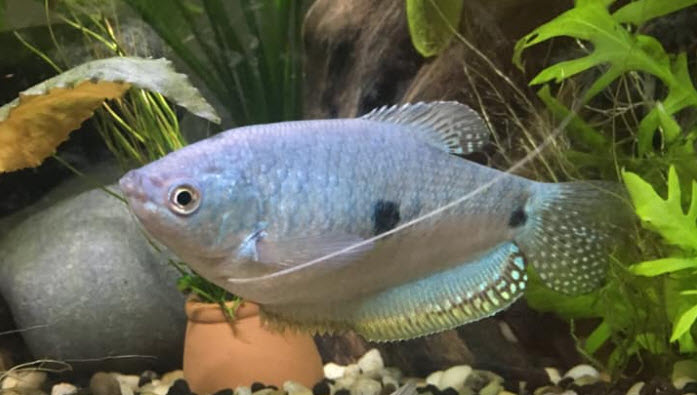
Aquarium Filter Myths
There are many myths parroted around social media about filters. These myths include:
- The brown “gunk” inside the filter bio-media or filter foam is trapped feces and it is beneficial to the aquarium to remove it frequently and thoroughly. This is the single biggest myth in the hobby and kills more fish than any other myth!
- Hang-on-back filters that use cartridges, such as Marineland Penguintm, Aqueon Quietflowtm, Tetra Whispertm, and Fluval Aqua-Cleartm, should have the cartridges replaced every month to three months. This is simply the biggest scam in the hobby. Don’t replace cartridges till they fall apart.
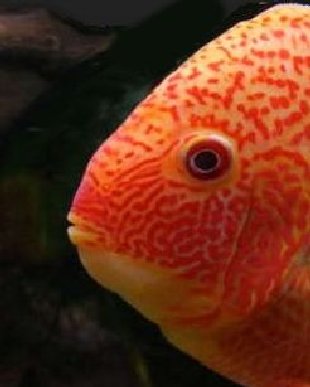
- Filters should be cleaned at least every month.
- Filters and sponges must be cleaned in aquarium water and never in chlorinated water.
- Under-gravel filters don’t work well.
- Hang-on-back filters are filters that give great biological filtration.
- Most canister filters filled with the media that comes with them (typically ceramic rings and bio-balls) are great biological filters.
- As long as the filtration is adequate to oxidize ammonia, more filtration will not help the health of the fish.
- The larger the filter the fewer nitrates in an aquarium and the fewer water changes required.
- There are bad types of filters called “nitrate factories”.

- Under-gravel filters need lots of maintenance.
- Only the flow rate in gallons per hour determines filter efficiency, not square feet of bio-media surface.
- A canister that has an actual flow rate of 600 GPH (gallons per hour) can filter roughly twice the amount of fish that a canister that has an actual flow rate of 300 GPH.
- “K1” fluidized beds take longer to cycle than standard submerged beds.
- “K1” fluidized beds are not as efficient as submerged static media beds.
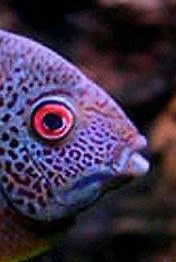
- Trickle filters are very efficient filters.
- Wet/dry filters are very good efficient filters.
- There are anaerobic nitrate removing reactor designs commercially available that work well in the aquarium.
.
All these myths are simply false
.
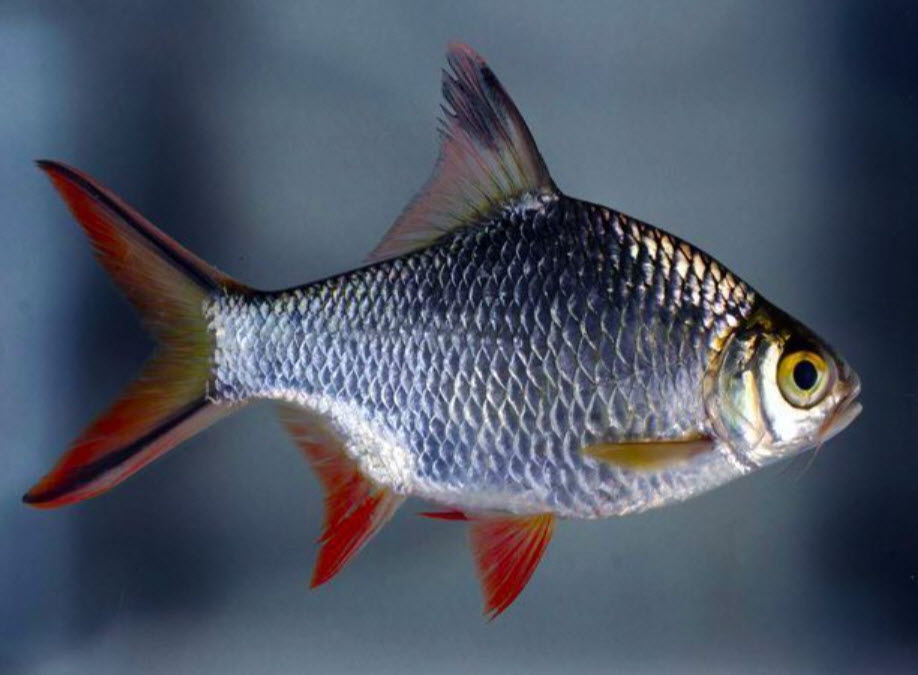
The beginner should always try to start with a few small fish, especially if one only has a small filter. Fish over three inches in length create much more waste than one realizes. A four-inch fish is eight times heavier than a two-inch fish. The four-inch fish creates eight times the waste of the two-inch fish. A beginner should start with just a few one to three-inch fish and ramp up. Design the filtration to handle the maximum load being contemplated.
Do NOT do what this beginner did:

I count 16 four to five-inch fish in a new aquarium with a tiny in-tank filter. This is a formula for disaster. The filter probably isn’t cycled and is FAR too small for the number and size of the fish. I predict that, sadly, most of the fish in this tank will be dead in a month. Again, have patience and do things SLOWLY. Only add new fish when the filter is big enough to do it. This aquarium needs a mature large canister filter and/or an undergravel filter. Also, the aeration on this aquarium appears to be minimal.
Filters in More Depth
To go into the subject of filters in-depth click on the following link:
8. Filters
.
Return to Guidelines for Beginners Menu
.
Aquarium Science Website
The chapters shown below or on the right side in maroon lead to close to 400 articles on all aspects of keeping a freshwater aquarium. These articles have NO links to profit-making sites and are thus unbiased in their recommendations, unlike all the for-profit sites you will find with Google. Bookmark and browse!
.

Dave says
In reply to Yan …. simply run the new filter alongside the old filter for at least four weeks.
Yan says
HI Dave,
I’m planning to upgrade my 50 gal aquarium canister filter. Sadly no UGF on this aquarium. There’s sand at the Botton but my gold fish love digging in the sand, so until they die I won’t change it.
I have a small Fluval canister, the one I’ll upgrade to a FX6, an HOB that I want to hey rid of and a sand filter that I wanted to test.
What’s the best way to change the filter without having to cycle it again.
I guess I’ll keep the HOB and sand filter running for several weeks. But what about the canister filter should I let both running until the new FX6 is able to at least oxidize ammonia?
What would be the best procedure to upgrade a filter.
Regards
Cleeon says
Dave, thanks so much, I’m learning a lot of knowledge from your article, and still in this chapter and continue to learning, once again thanks so much for sharing your knowledge and experience regarding this matter.
Patty g says
It’s so great reading someone who actually utilizes logic and research instead of just parroting misnomers confidently like you see on facebook and reddit
Dave says
In reply to Era …. Replace all the biospheres with K1, foam, or pot scrubbers (whatever is cheapest in Singapore). And I would leave the foam media in place if it is 30 ppi or 20 ppi. Foam is actually a very good biological media as long as it isn’t 40 ppi foam.
Era Mahendran says
Hi, I’m from Singapore and I have been following you for more than 6 months and your recommended medication helped save the entire discus population in my home from Black Death.
I use for all my tanks the Oase Biomaster Canisters – can I know what your recommendation of the filter media that I should use – the prefilters are mostly 30ppi and 45 ppi.
Inside the main trays are filled with biospheres and K1 media – the top ones are in a zipper bag and below as moving K1s and the last trays are either zipped K1s or biospheres.
I’ve a sump tank filled with K1 Fluvidized Moving media in 1 chamber and the other are mechanical sponge filters which I’m going to replace with Plastic Pot Scrubbers – the other 2 chambers are filled with Biospheres.
Again, I need your recommendation for the sump media.
BTW, I run over filtration for my discus with at least 3 filters – Canister, K1 Moving and sponge filters.
Getting crystal clear waters and loaded with more than 15 discus in each tank according to size, eating hi-protein diet and growing well.
Thank you for this wonderful site.
Era